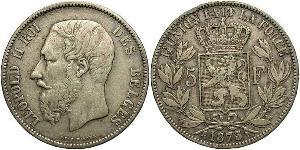(sold for $22.0)
Kushan Empire, Huvishka (152-190 AD) Æ Tetradrachm "Elephant" Coin. F-VF!
Mint Period:152-190 AD Denomination: Æ Tetradrachm References: Göbl 855, MACW # 3289. Condition: Lightly pitted by corrosion, green patina, otherwise F-VF! Diameter: 24mm Material: Bronze Weight: 9.18gm
Obverse: Huvishka holding ankush and seated on elephant standing right.
Reverse: Deity of royal glory Pharro standing left, holding spear in raised left hand, with right hand outstretched, offering diadem. Tamgha (state seal of the King) to left.
One of the great remaining puzzles of Huvishka's reign is the devaluation of his coinage. Early in his reign the copper coinage plunged in weight from a standard of 16g to about 10-11g. The quality and weight then continued to decline throughout the reign until at the start of the reign of Vasudeva the standard coin (a tetradrachm) weighed only 9g. The devaluation led to a massive production of imitations, and an economic demand for the older, pre-devaluation coins in the Gangetic valley. However, the motivation (and even some of the details) of this devaluation are still unknown.
The Kushan Empire (Ancient Greek: Βασιλεία Κοσσανῶν; Bactrian: Κυϸανο, Kushano) was a syncretic empire, formed by the Yuezhi, in the Bactrian territories in the early 1st century. It spread to encompass much of Afghanistan, and then the northern parts of the Indian subcontinent at least as far as Saketa and Sarnath near Varanasi (Benares), where inscriptions have been found dating to the era of the Kushan Emperor Kanishka the Great. Emperor Kanishka was a great patron of Buddhism. He played an important role in the establishment of Buddhism in the Indian subcontinent and its spread to Central Asia and China.
The Kushans were most probably one of five branches of the Yuezhi confederation, an Indo-European nomadic people of possible Tocharian origin, who migrated from Gansu and settled in ancient Bactria.
The Kushans possibly used the Greek language initially for administrative purposes, but soon began to use Bactrian language. Kanishka sent his armies north of the Karakoram mountains. A direct road from Gandhara to China remained under Kushan control for more than a century, encouraging travel across the Karakoram and facilitating the spread of Mahayana Buddhism to China.
The Kushan dynasty had diplomatic contacts with the Roman Empire, Sasanian Persia, the Aksumite Empire and the Han dynasty of China. The Kushan Empire was at the center of trade relations between the Roman Empire and China: according to Alain Daniélou, "for a time, the Kushana Empire was the centerpoint of the major civilizations". While much philosophy, art, and science was created within its borders, the only textual record of the empire's history today comes from inscriptions and accounts in other languages, particularly Chinese.
The Kushan empire fragmented into semi-independent kingdoms in the 3rd century AD, which fell to the Sasanians invading from the west, establishing the Kushano-Sasanian Kingdom in the areas of Sogdiana, Bactria and Gandhara. In the 4th century, the Guptas, an Indian dynasty also pressed from the east. The last of the Kushan and Kushano-Sasanian kingdoms were eventually overwhelmed by invaders from the north, known as the Kidarites, and then the Hephthalites.
Huvishka (Kushan: Οοηϸκι, "Ooishki") was the emperor of the Kushan Empire from the death of Kanishka (assumed on the best evidence available to be in 150 CE) until the succession of Vasudeva I about thirty years later.
His rule was a period of consolidation for the Empire. Huvishka's territory encompassed Balkh in Bactria to Mathura in India, locations were it is known that he minted his coinage. His reign seems to have been essentially peaceful, consolidating Kushan power in northern India, and moving the center of the Kushan Empire to the southern capital city of Mathura.
Huvishka was the son of Kanishka. His reign is also known as the golden age of Kushan rule. The reign of Huvishka corresponds to the first known epigraphic evidence of the Buddha Amitabha, on the bottom part of a 2nd-century statue which has been found in Govindo-Nagar, and now at the Mathura Museum. The statue is dated to "the 28th year of the reign of Huvishka", and dedicated to "Amitabha Buddha" by a family of merchants. There is also some evidence that Huvishka himself was a follower of Mahāyāna Buddhism. A Sanskrit manuscript fragment in the Schøyen Collection describes Huvishka as one who has "set forth in the Mahāyāna."
Compared to his predecessor Kanishka, Huvishka was worshipper of Shiva.
He also incorporates in his coins for the first and unique time in Kushan coinage the Hellenistic-Egyptian Serapis (under the name Σαραπο, "Sarapo"[7]), and the Goddess Roma (thought to represent "Roma aeterna"), under the name "Riom" (Greek: ΡΙΟΜ).
Some of the coins of Huvishka also featured Maaseno on his coins, the Kushan incarnation of the Hindu god Karttikeya, or Skanda, whose epithet was "Mahasena".[citation needed] This god being particularly important to the Yaudheyas, it may have been incorporated into Kushan coinage when the Kushans expanded into Yaudheya territory in order to establish control of the Mathura area. It may also have been adopted as a way to appease the warlike Yaudheyas. In effect, the Kushans became the suzerains of the Yaudheyas in the area.
Only 1$ shipping for each additional item purchased!

|
Posted by:
anonymous 2020-04-26 |
1/4 Thaler Salzburg Silver Johann Ernst von Thun und Hohenstein
group has 6 coins / 5 prices
⇑
5 Franc Belgium Silver Leopold II of Belgium(1835 - 1909)
group has 128 coins / 110 prices
⇑















